Historical Character Guide
Early Middle Ages (500 AD – 1000 AD)
The Early Middle Ages was a rapid time of change following the fall of the Western Roman Empire and the great migrations. The foundation of new kingdoms in Western Europe, those especially of the Carolingians and the Kings of Wessex began at this time; while the east thrived under the Eastern Roman Empire it’s position of power was soon to be challenged by their new Muslim rivals to their south and an even more formidable foe from Central Asia. It was also the age of the vikings, who plundered the coasts and rivers of Europe for 300 years. It was a time of exploration, the rise and fall of empires and the very beginnings of Medieval Europe itself.
Viking Housecarl
Mid 9th Century
The Vikings were feared as they were renowned warriors, and left a lasting legacy in both East and Western Europe. The Housecarls were fighting men serving their lord or king as part of an elite retinue, they fought at his side and defended him even to a violent grave.
Armour:
- Head: Viking Helmet, Spangenhelm Stripped, Spangenhelm
- Neck: Nothing, Fur Coif, Aventail, Aventail Lowered
Torso: Chainmail - Shoulders: Nothing, Short Mantle, Workers Scarf, Wanderers Scarf
- Arms: Long Sleeve Cloth, Rolled Cloth
- Hands: Nothing
- Waist: Chainmail Lower
- Legs: Baggy Pants
- Feet: Footsoldier Boots, Fur Boots
Gear:
- Primary: Battle Axe – Berzerker Head, Narrow Beard Head – Long Shaft
- Secondary: Arming Sword (Viking) – Any Blade, guard and handle
- Tertiary: Targe
Frankish Horseman
Mid 8th Century
The best fighting men of the Frankish Empire, these horsemen were the crusaders of their day and helped to extend the Frankish Empire across Europe and would serve as an inspiration for the chivalrous knight centuries later.
Armour:
- Head: Spanish Kettle, Norman Casque, Norman Casque No Nasal Guard
- Neck: Maille Hood Lowered, Padded Coif, Helmet Strap
- Torso: Chainmail, Plate Lamellar Cuirass,
- Shoulders: Nothing, Short Mantle, Workers Scarf, Wanderers Scarf,
- Arms: Long Sleeve Cloth, Rolled Cloth
- Waist: Crude Plate Skirt (Lamellar only)
- Legs: Pants, Baggy Pants
- Feet: Laced Boots, Footsoldier Boots
Gear:
- Primary: Short Spear (Optional)
- Secondary: Arming Sword (Viking), Any Blade, guard and handle.
- Tertiary: Targe
Saxon Fyrd
Mid 9th Century
These freemen are levied up in times of war to serve their lord or king and have done so for centuries in battles against foreign invaders, or against fellow saxons.
Armour:
- Head: Nothing, Norman Casque No Nasal Guard
- Neck: Nothing
- Torso: Tunic, Peasants Shirt
- Shoulders: Nothing, Workers Scarf
- Arms: Long Sleeve Cloth, Rolled Cloth
- Hands: Nothing
- Waist: Nothing
- Legs: Baggy Pants
- Feet: Pointy Leather Shoes
Gear:
- Primary: Short Spear, Throwing Axe, Rocks
- Secondary: Cleaver, Axe
- Tertiary: Targe
High Middle Ages (1000AD – 1300AD)
The High Middle Ages was a time of rapid growth and the beginning of the 12th century Renaissance in Europe, with the foundations of major nations like England and France having being set in stone. Populations boomed quickly as agriculture and commerce grew stronger, such as with the Hanseatic League and merchant republics of Venice and Genoa. The Crusades against the Muslims saw to reclaim the ‘holy lands’ of Palestine, and while initially successful ultimately proved fruitless. However progress was made with the Reconquista following a decisive battle at Las Navas de Tolosa that now put the Moors at the mercy of the Iberian Christian kingdoms. This would also be the era that the Mongol Empire would encroach upon the Middle East and Christendom, and when Byzantium’s power was crippled with the Sack of Constantinople in 1204.
Saxon Housecarl
Mid 11th Century
Much alike to their viking counterparts, the Anglo-Saxons adopted housecarls as a part of their retinue. They were fierce warriors, famous for defeating the Norwegians at the Battle of Stamford Bridge, and fighting to the bitter end at Hastings in 1066.
Armour:
- Head: Norman Casque, Norman Casque No Nasal Guard
- Neck: Helmet Strap, Aventail lowered
- Torso: Chainmail
- Shoulders: Nothing, Short Mantle, Workers Scarf, Wanderers Scarf
- Arms: Long Sleeve Cloth, Rolled Cloth
- Hands: Nothing, Leather Gloves
- Waist: Chainmail Lower
- Legs: Baggy Pants
- Feet: Footsoldier Boots, Laced Boots, Pointy Leather Boots, Chain Boots
Gear:
- Primary: Battle Axe – Berzerker Head, Narrow Beard Head – Long Shaft
- Secondary: Arming Sword (Viking) – Any Blade, guard and handle
- Tertiary: Targe
Knight
Mid 12th – Late 13th Century
The Knight was a force to be reckoned with, having being trained from birth to not only fight, but also in the mannerisms with life at court. Of these esteemed warriors, several military orders arose out of a sense of zealotry and glory during the time of The Crusades. Most notably the Templars and the Hospitallers in the Holy Land, while the Teutonic and Livonian Orders operated in the Baltic.
Armour:
- Head: Aventail Lowered, Norman Casque, Norman Casque No Nasal Guard, Kettle, Flat
- Top, Conic Facemask, Flat Templar, Greathelm, (any variant)
- Neck: Coif, Helmet Strap, Aventail, Aventail Lowered, Fur Coif,
- Torso: Tabard
- Shoulders: Nothing, Short Mantle, Workers Scarf, Wanderers Scarf
- Arms: Chainmail Arms
- Hands: Chainmail Mittens
- Waist: Tabard Skirt
- Legs: Chainmail Hosen, Padden Chainmail Hosen
- Feet: Laced Boots, Pointy Leather Boots, Townsmans Shoes
Gear:
- Primary: Arming Sword, Bastard Sword, Mace, Axe, Battle Axe
- Secondary: Kite Shield, Heater Shield
- Tertiary: Dagger (Crucifix)
Emblem/Colours for Military Orders:
- Knights Templar: Templar Cross 2 (Red – White Background)
- Knights Hospitaller: Templar Cross 3 (White – Black or Red Background)
- Teutonic Order: Templar Cross 2 (Black – White Background)
- Knights of the Holy Sepulchre: Templar Cross 1 (Red – White Background)
- Order of St.Lazarus: Templar Cross 3 (Green- White Background)
Crossbowman
Mid 12th – Late 13th Century
Crossbows had been in use since Roman times, but they surged in popularity in the Middle Ages garnering a reputation for being deadly in accuracy and power. The Catholic Church tried to ban the use of archery weapons, especially crossbows on fellow Christians but it wasn’t long before everyone went back to their old habits.
Armour:
- Head: Aventail Lowered, Norman Casque, Norman Casque No Nasal Guard, Kettle, Eisenhut Flat Top
- Neck: Coif, Arming Cap, Helmet Strap, Aventail, Aventail Lowered
- Torso: Gambeson, Chainmail, Tabard
- Shoulders: Nothing
- Arms: Gambeson Tight Sleeve, Long Sleeve Cloth, Rolled Cloth, Chainmail Arms
- Hands: None, Leather Gloves
- Waist: Gambeson Skirt, Chainmail Lower, Tabard Skirt
- Legs: Pants, Baggy Pants, Chainmail Hosen
- Feet: Laced Boots, Pointy Leather Boots, Chain Boots, Footsoldier Boots
Gear:
- Primary: Crossbow
- Secondary: Short Sword, Dagger (Crucifix) Arming Sword, Axe
Welsh Archer
Mid 12th Century
The use of archers in war declined in Western Europe for the most part. But there was a slow revival in the High Middle Ages. Though, the Welsh had mastered the art since the 7th Century and especially the Longbow which would later be adopted by the English.
Armour:
- Head: Nothing, Hood, Peasant Cap
- Neck: Nothing, Hood Lowered
- Torso: Tunic, Peasant Shirt, Workers Vest
- Shoulders: Nothing
- Arms: Long Sleeve Cloth
- Hands: Nothing, Leather Gloves
- Waist: Nothing
- Legs: Pants, Baggy Pants
- Feet: Laced Boots, Pointy Leather Boots, Chain Boots, Footsoldier Boots
Gear:
- Primary: Longbow
- Secondary: Short Sword, Dagger (Crucifix) Arming Sword, Axe
High Period Infantry
Early 12th – Late 13th Century
Though more or less knight fodder in their time, these soldiers are still armed with some decent enough weapons to fend for themselves. Drawn from middle-class freemen and peasants, they act as militia for towns and villages, while more professional soldiery march on campaigns with their lords. They along with archers, played a vital role in the crusades to help keep the mounted Saracens at bay
- Head: Aventail Lowered, Norman Casque, Norman Casque No Nasal Guard, Kettle, Eisenhut Flat Top.
- Neck: Arming Cap, Coif, Helmet Strap, Aventail, Aventail Lowered.
- Torso: Gambeson, Chainmail, Tabard
- Shoulders: Nothing.
- Arms: Gambeson Tight Sleeve, Long Sleeve Cloth, Rolled Cloth, Chainmail Arms.
- Hands: None, Leather Gloves.
- Waist: Gambeson Skirt, Chainmail Lower, Tabard Skirt
- Legs: Pants, Baggy Pants, Chainmail Hosen.
- Feet: Laced Boots, Pointy Leather Boots, Chain Boots, Footsoldier Boots
Gear:
- Primary: Short Spear, Battle Axe, Spear
- Secondary: Short Sword, Dagger (Crucifix) Arming Sword, Axe, Mace
- Tertiary: Kite Shield, Heater Shield
Almogavar
Mid 13th Century
Originating from the Kingdom of Aragon originally as farmers and shepherds. These highly acclaimed shock infantry have a reputation for raiding the borders of Al-Andalus and later serving as mercenaries. Wearing little to no armour, they harass their enemies with javelins and carry a trusty knife at their side.
Armour:
- Head: Nothing, Peasant Cap, Norman Casque No Nasal Guard
- Neck: Nothing
- Torso: Tunic, Workers Vest, Wanderers Vest
- Shoulders: Nothing.
- Arms: Nothing, Long Sleeve Cloth, Rolled Cloth
- Hands: None
- Waist: Nothing
- Legs: Pants, Workers Shorts, Wonderers Shorts, Baggy Pants
- Feet: Nothing, Pointy Leather Boots, Footsoldier Boots
Gear:
- Primary: Javelin
- Secondary: Short Spear
- Tertiary: Cleaver
- High Middle Ages Continued…
Varangian Guard
Mid 13th Century
Taking form in the 10th Century recruiting Rus, Norsemen and later Anglo-Saxons, the Varangian Guard is one of most acclaimed in the Byzantine Empire. Serving as the Emperor’s own guard, they also participated in battle where they played a crucial role.
Armour:
- Head: Kettle
- Neck: Bishops Mantle, Aventail Lowered
- Torso: Plate Lamellar Cuirass
- Shoulders: Nothing, Lamellar Shoulders
- Arms: Brigandine Arms, Vambrace Arms
- Hands: None, Leather Gloves.
- Waist: Chainmail Skirt, Lamellar Skirt
- Legs: Pants, Wanderers Pants, Footmans Splinted Greaves
- Feet: Laced Boots, Pointy Leather Boots, Townsman Shoes
Gear:
- Primary: Battle Axe – Long Shaft, Berzerker Head
- Secondary: Arming Sword, Falchion
- Tertiary: Targe
Emblem: Chimera
Skoutatoi
Early 12th Century
Making up the bulk of the Byzantine Empire’s Infantry. The Skoutatoi, named after their “Skouton” shields fought in a tight formation of spears to lend aid to the cavalry.
Armour:
- Head: Norman Casque No Nasal Guard
- Neck: Arming Cap
- Torso: Plate Lamellar Cuirass
- Shoulders: Nothing
- Arms: Brigandine Arms
- Hands: None, Leather Gloves.
- Waist: Crude Plate Skirt
- Legs: Pants, Wanderers Pants, Footmans Splinted Greaves
- Feet: Laced Boots, Footsoldiers Boots, Pointy Leather Boots
Gear:
- Primary: Short Spear
- Secondary: Arming Sword, Axe, Falchion
- Tertiary: Kite Shield
Toxotai
Early 12th Century
The standard light infantry of the Byzantine Empire. Most archers of the empire came from Asia Minor in the region of Trebizond where they are highly trained with the composite (recurve) bow.
- Head: Norman Casque No Nasal Guard
- Neck: Arming Cap
- Torso: Gambeson
- Shoulders: Nothing
- Arms: Rolled Cloth, Long Sleeve Cloth.
- Hands: None, Leather Gloves.
- Waist: Gambeson Skirt.
- Legs: Pants, Wanderers Pants
- Feet: Laced Boots, Footsoldiers Boots, Pointy Leather Boots
Gear:
- Primary: Recurve Bow
- Secondary: Arming Sword, Axe
- Tertiary: Dagger
Late Middle Ages (1300AD – 1500AD)
The Late Middle Ages saw a rapid period of change, and upheaval. Crises such as the Hundred Years War, the Western Schism and the Black Death rocked Europe to it’s core, feudalism was strained with the lack of manpower to work the fields following the plague which led to peasant revolts in France and England demanding the end of serfdom and a reduction of taxes. In the Kingdom of Bohemia, the Hussite uprising occurred demanding for more sociopolitical freedom and religious reform that would set the trend for more religious wars in Europe for the next two centuries. As the Ottoman Empire swiftly conquered the Balkans, Byzantine scholars fled west to Italy, which would set the stage for the Italian Renaissance and the Age of the Discovery.
Scottish Pikeman
Early 14th Century
English Knights were a presence to be feared on the battlefield so the Scots developed a means to counter them with pikemen to keep them at bay. While helpless to missiles, the Scots were able use them to great effect at Stirling Bridge and Bannockburn.
Armour:
- Head: Aventail Lowered, Norman Casque, Norman Casque No Nasal Guard, Kettle.
- Neck: Coif, Helmet Strap, Aventail, Aventail Lowered
- Torso: Gambeson, Chainmail, Tabard
- Shoulders: Nothing
- Arms: Long Sleeve Cloth, Gambeson Tight Sleeve, Chainmail Arms
- Hands: Nothing, Leather Gloves, Chainmail Mittens
- Waist: Gambeson Skirt, Chainmail Lower, Tabard Skirt
- Legs: Pants, Baggy Pants, Chainmail Hosen, Padden Chainmail Hosen
- Feet: Laced Boots, Pointy Leather Boots, Chain Boots
Gear:
- Primary: Spear
- Secondary: Arming Sword, Axe, Mace
- Tertiary: Dagger (Crucifix), Targe
Knight
Early 14th Century-Late 14th Century
In an age of rapid armour development, the 14th century saw a transitional period towards plate armour with partial plate and mail armour. Knights began to wear breastplates and steel plates on their limbs, and visored helmets such as the hounskull to deflect arrows.
Armour: Early 14th Century
- Head: Greathelm (any variant), Unvisored Klappvisier, Barbute Visor
- Neck: Aventail Lowered, Aventail Tightened
- Torso: Tabard
- Shoulders: Nothing, Basic Shoulders Round, Basic Shoulders Square
- Arms: Chainmail Arms, Chainmail Arms Padded
- Hands: Nothing, Leather Gloves, Chainmail Mittens
- Waist: Tabard Skirt
- Legs: hainmail Hosen, Padden Chainmail Hosen, Brigandine Greaves
- Feet: Pointy Leather Boots, Townsmans Shoe
Armour: Mid-Late 14th Century
- Head: Klappvisier, Italian Klappvisier, Unvisored Klappvisier, Hounskull
- Neck: Aventail Lowered, Aventail Tightened
- Torso: Brigandine, Draped Cuirass, Padded Cuirass
- Shoulders: Nothing, Knight Pauldrons 1×1
- Arms: Crude Plate Arms, Footsoldier Arms
- Hands: Hourglass Gauntlets, Wisby Gauntlets
- Waist: Short Chainmail Skirt
- Legs: Brigandine Greaves, Footsoldier Greaves
- Feet: Pointy Leather Boots, Townsmans Shoe
Gear:
- Primary: Longsword, Bastard Sword, Maul, Poleaxe, Eveningstar, Messer
- Secondary: Arming Sword, Axe, Mace, Dagger
- Tertiary: Heater Shield, Buckler
English Longbowman
Mid 14th Century
Made famous by many battles such as Crecy, Poitiers and Agincourt, Longbowmen were the driving force of the English armies in France and the British Isles. Being highly skilled with their longbow, they can also fend well for themselves in melee.
Armour:
- Head: Aventail Lowered, Kettle, Hood, Eisenhut, Unvisored Klappvisier, Hounskull No Visor
- Neck: Arming Cap, Aventail Lowered, Helmet Strap, Hood Lowered, Hood
- Torso: Gambeson, Checkered Gambeson, Chainmail, Brigandine
- Shoulders: Nothing, Basic Shoulders Round
- Arms: Long Sleeve Cloth, Gambeson Tight Sleeve, Chainmail Arms
- Hands: Nothing, Leather Gloves
- Waist: Gambeson Skirt, Chainmail Lower
- Legs: Pants, Baggy Pants
- Feet: Laced Boots, Pointy Leather Boots, Footsoldier Boots
Gear:
- Primary: Longbow
- Secondary: Arming Sword, Shortsword, Axe, Wooden Mallet, Cleaver
- Tertiary: Dagger
Infantry
14th Century
As early as the late 13th century, infantry were beginning to make more of a presence in warfare in retinues and mercenary companies with improved weapons and armour. Infantry were able to be fielded in larger numbers while being cheaper than fielding knights. At the same time, new tactics were developed to counter said knights as more emphasis was placed in the use of pole-arms.
Armour:
- Head: Eisenhut, Kettle, Unvisored Klappvisier, Hounskull No Visor
- Neck: Arming Cap, Padded Coif, Maille Hood Lowered, Helmet Strap, Hood Lowered, Aventail Lowered
- Torso: Gambeson, Checkered Gambeson, Doublet Padded, Chainmail, Brigandine, Padded Cuirass
- Shoulders: Nothing, Basic Shoulders Round
- Arms: Gambeson Tight Sleeve, Chainmail Arms, Chainmail Arms Padded, Splinted Arms
- Hands: Nothing, Leather Gloves, Hourglass Gauntlets, Wisby Gauntlets
- Waist: Nothing, Gambeson Skirt, Checkered Gambeson Skirt, Chainmail Lowered, Short Chainmail Skirt
- Legs: Pants, Baggy Pants, Padded Chainmail Hosen, Calf Guard Hosen, Splinted Greaves, Brigandine Greaves, Footsoldier Leggings
- Feet: Pointy Leather Shoes, Chain Boots, Laced Boots, Footsoldier Boots, Townsmans Shoe, Folded Boots
Gear:
- Primary: Spear, Bardiche, Battle-Axe, Billhook, Eveningstar,
- Secondary: Arming Sword, Axe, Mace, Falchion, Heavy Handaxe
- Tertiary: Dagger, Heater Shield
Late Middle Ages Continued…
Knight
Early-Late 15th Century
Worn by knights and men-at-arms alike. Full suits of plate armour were developed by 1420. Two distinct styles emerged in this era and were diffused across Europe. The plainer Italian “white” armour, and the decorative German “gothic” armour. Both functioned just the same, and the wearer was near impervious to most edged weapons, including arrows.
Armour: Italian
- Head: Barbute, Regular Armet, Sallet Bevor
- Neck: Gorget
- Torso: Italian Cuirass
- Shoulders: Knight Pauldrons 2×2, Knight Pauldrons 2×3
- Arms: Footsoldiers Arms
- Hands: Fanned Segmented Gauntlets (I haven’t unlocked these yet, will update when I do)
- Waist: Short Chainmail Skirt
- Legs: Footsoldier Leggings
- Feet: Pointy Leather Shoes
Armour: German (My personal favourite)
- Head: Sallet Bevor
- Neck: Footsoldier Gorget
- Torso: Gothic Cuirass
- Shoulders: Gothic Pauldrons
- Arms: Gothic Arms
- Hands: Gothic Gauntlets
- Waist: Short Chainmail Skirt
- Legs: Gothic Leggings
- Feet: Gothic Sabatons
Gear:
- Primary: Longsword, Maul, Messer, Bastard Sword
- Secondary: Arming Sword, Mace, Warhammer, Axe, Heavy Handaxe,
- Tertiary: Dagger, Buckler
Mercenary Genoese Crossbowman
15th Century
Offering out their services to anyone who can afford them be it at land or sea. These mercenaries trace their origins to the crusades, and became highly respected for their deadly skills with a crossbow before their decline in the 16th century.
Armour:
- Head: Archers Cap, Archers Cap Feather, Eisenhut, Kettle, Barbute, Sallet Raised Visor
- Neck: Nothing, Arming Cap, Maille Hood Lowered, Helmet Strap
- Torso: Brigandine
- Shoulders: Basic Shoulders Round
- Arms: Footsoldiers Arms
- Hands: Nothing, Leather Gloves
- Waist: Short Chainmail Skirt
- Legs: Pants, Linen Hosen
- Feet: Pointy Leather Shoes, Chain Boots
Gear:
- Primary: Crossbow
- Secondary: Arming Sword, Shortsword
- Tertiary: Pavise
Hussite
Early-Mid 15th Century
The Hussites were the followers of Jan Hus, a preacher who called for reform in the split Catholic Church. With their Wagenburg (Wagon Fort) tactics, they were able to withstand five crusades directed at them in what would be called the Hussite Wars.
Armour:
- Head: Eisenhut, Hood, Sallet, Sallet Raised Visor, Kettle, German Kettle
- Neck: Nothing, Arming Cap, Maille Hood Lowered, Helmet Strap, Hood Lowered
- Torso: Gambeson, Checkered Gambeson, Chainmail, Padded Cuirass
- Shoulders: Nothing
- Arms: Long Sleeve Cloth, Gambeson Tight Sleeve, Chainmail Arms
- Hands: Nothing, Leather Gloves, Crude Gauntlets, Hourglass Gauntlets
- Waist: Nothing, Gambeson Skirt, Checkered Gambeson Skirt, Chainmail Lowered
- Legs: Pants, Baggy Pants
- Feet: Pointy Leather Shoes, Chain Boots, Laced Boots, Footsoldier Boots
Gear:
- Primary: Crossbow, Eveningstar (Abendstern), Halberd, Poleaxe, Bardiche
- Secondary: Arming Sword, Bastard Sword, Axe, Mace
- Tertiary: Pavise, Wooden Mallet, Blacksmith Hammer
Italian Mercenary Infantry
Mid-Late 15th Century
The Italian city states were more often than not in a state of war, with one of the main driving conflicts being a part of the Investiture Controversy between the Pope and the Holy Roman Emperor. These wars were often fought by mercenaries, who served either directly on campaign or to protect the outposts and trade of powerful trade republics like Venice and Florence.
Armour:
- Head: Sallet, Sallet Raised Visor, Kettle, German Kettle, German Kettle Raised, Barbute
- Neck: Nothing, Arming Cap, Maille Hood Lowered, Helmet Strap, Heavy Bevor, Gorget, Footsoldier Gorget
- Torso: Chainmail, Italian Cuirass, Brigandine, Draped Cuirass
- Shoulders: Nothing, Footmans Pauldrons, Segmented Pauldrons, Knight Pauldrons 2×2,
- Arms: Footsoldier Arms, Crude Plate Arms, Gambeson Tight Sleeve
- Hands: Nothing, Leather Gloves, Hourglass Gauntlets, Gothic Gauntlets, Fanned Segmented Gauntlets, Basic Segmented Gauntlets
- Waist: Nothing, Short Gambeson, Short Chainmail Skirt
- Legs: Pants, Linen Hosen, Calf Guard Hosen, Footsoldier Leggings
- Feet: Pointy Leather Shoes, Chain Boots, Laced Boots, Footsoldier Boots, Folded Boots
Gear:
- Primary: Maul, Billhook, Pole-Axe
- Secondary: Arming Sword, Axe, Heavy Hand Axe, Mace, Falchion, Warhammer
- Tertiary: Dagger, Buckler, Heater Shield
Swiss Pikeman
Mid-Late 15th Century
With their mastery of the pike, the Swiss out carved a series of decisive victories across Europe over the course of the 14th and 15th centuries, their most famous battles being during the Burgundian Wars where they humiliated one of the most powerful rulers in Europe at the time, Charles the Bold.
Armour:
- Head: Sallet, Sallet Raised Visor, Kettle, German Kettle, Landsknecht Hat, Landsknecht Hat Feather, Eisenhut, Archers Cap, Archers Cap Feather, Chaperon Hat.
- Neck: Nothing, Arming Cap, Maille Hood Lowered, Helmet Strap, Hood Lowered, Heavy Bevor, Gorget, Footsoldier Gorget
- Torso: Doublet Padded, Italian Cuirass, Gothic Cuirass, Brigandine
- Shoulders: Nothing, Footsoldier Pauldrons, Segmented Pauldrons, Knight Pauldrons 2×2, Gothic Pauldrons
- Arms: Footsoldier Arms, Long Sleeve Cloth, Gambeson Tight Sleeve, Gothic Arms
- Hands: Nothing, Leather Gloves, Hourglass Gauntlets, Gothic Gauntlets, Fanned Segmented Gauntlets, Basic Segmented Gauntlets
- Waist: Nothing, Short Gambeson, Short Chainmail Skirt,
- Legs: Pants, Linen Hosen
- Feet: Pointy Leather Shoes, Chain Boots, Laced Boots, Footsoldier Boots, Folded Boots
Gear:
- Primary: Spear, Halberd, Bardiche, Pole Axe
- Secondary: Arming Sword, Axe, Mace
- Tertiary: Dagger, Buckler
Billman
Mid-Late 15th Century
Originally starting off as a farm tool, the bill evolved into a versatile pole arm that soared in popularity in England and Italy. The bill’s curved head allowed for not only a powerful cut, but to catch gaps in plate armour that could be used to drag a horseman off his mount. It is also equipped with a pronounced spike for stabbing and another armour piercing spike on it’s rear.
Armour:
- Head: Sallet, Sallet Raised Visor, Kettle, German Kettle, Eisenhut
- Neck: Nothing, Arming Cap, Maille Hood Lowered, Helmet Strap, Heavy Bevor, Gorget, Footsoldier Gorget
- Torso: Doublet Padded, Italian Cuirass, Brigandine, Draped Cuirass
- Shoulders: Nothing, Footsoldier Pauldrons, Segmented Pauldrons
- Arms: Footsoldier Arms, Gambeson Tight Sleeve
- Hands: Nothing, Leather Gloves, Hourglass Gauntlets, Gothic Gauntlets, Fanned Segmented Gauntlets, Basic Segmented Gauntlets
- Waist: Nothing, Short Gambeson, Short Chainmail Skirt,
- Legs: Pants, Linen Hosen, Footsoldier Leggings,
- Feet: Pointy Leather Shoes, Chain Boots, Laced Boots, Footsoldier Boots, Folded Boots
Gear:
- Primary: Billhook
- Secondary: Arming Sword, Axe, Mace
- Tertiary: Dagger, Buckler
The Renaissance (1500AD – 1600AD)
The days of the knight were coming to an end, favouring new advancements in gunpowder weapons and battle tactics, as well as economic and social shifts. The Renaissance gave birth to the modern world, a revolutionary age of science, art, discovery and enlightenment. The Age of Discovery broadened Europe’s scope of the world with sights set on new opportunities and adventure. But even with all these advances, there was still much turmoil. Conflicts such as the Italian Wars and the terrible struggle against the encroaching Ottoman Empire would last for decades, and the whole continent of Europe would be fractured by the reformation. When they weren’t fighting each other, Europeans would take their swords to the new world rife for conquest.
Doppelsöldner
Early 16th Century
The Doppelsöldner were Landsknecht mercenaries volunteering to fight on the front line for double the pay. Usually issued with a crossbow or arquebus, some also carried their famous Zweihänders that they used to cut into pike formations, especially those of the Swiss.
Armour:
- Head: Landsknecht Hat, Landsknecht Hat feather, Burgonet, Burgonet no Buffet
- Neck: Nothing, Gorget
- Torso: Landsknecht Vest, Elizabethan Cuirass, Footsoldier Cuirass, Maximillian Cuirass
- Shoulders: Nothing
- Arms: Landsknecht Arms
- Hands: Nothing, Leather Gloves
- Waist: Nothing
- Legs: Landsknecht Pants
- Feet: Landsknecht Sandals, Laced Boots, Folded Boots
Gear:
- Primary: Crossbow, Zweihänder, Halberd
- Secondary: Rapier, Estoc, Messer, Warhammer
- Tertiary: Dagger
Conquistador
Early-Mid 16th Century
Hardy and brutal pioneers of the Spanish and Portuguese Empires. The conquistadors sailed out from their homelands conquering large swathes of territory, establishing new colonies and trade routes.
Armour:
- Head: Spanish Kettle
- Neck: Nothing, Gorget, Footsoldier Gorget
- Torso: Elizabethan Cuirass, Footsoldier Cuirass, Maximillian Cuirass
- Shoulders: Nothing, Knight Pauldrons 2×3, Knight Pauldrons 3×3
- Arms: Landsknecht Arms, Footsoldier Arms
- Hands: Nothing, Leather Gloves
- Waist: Nothing
- Legs: Landsknecht Pants
- Feet: Landsknecht Sandals, Laced Boots, Folded Boots
Gear:
- Primary: Crossbow
- Secondary: Rapier, Estoc, Warhammer
- Tertiary: Dagger, Targe
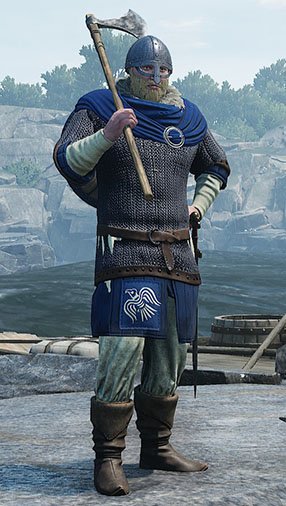
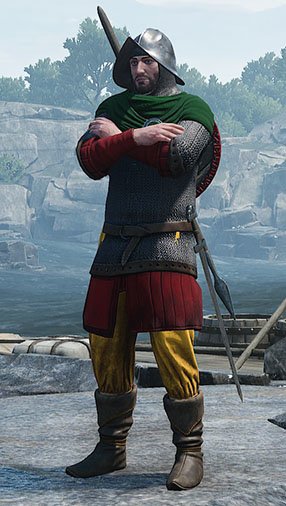
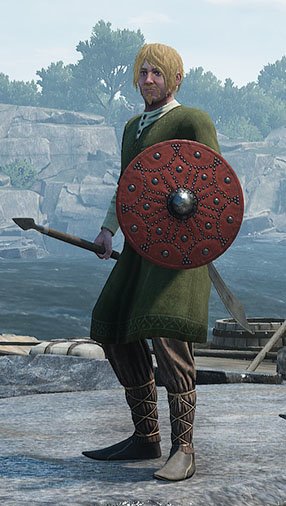
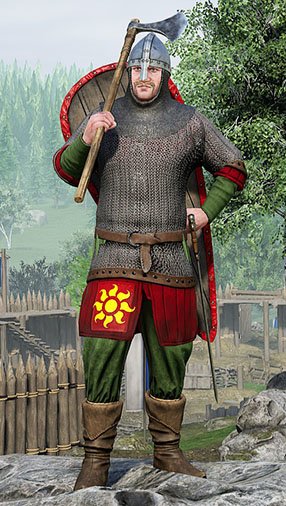
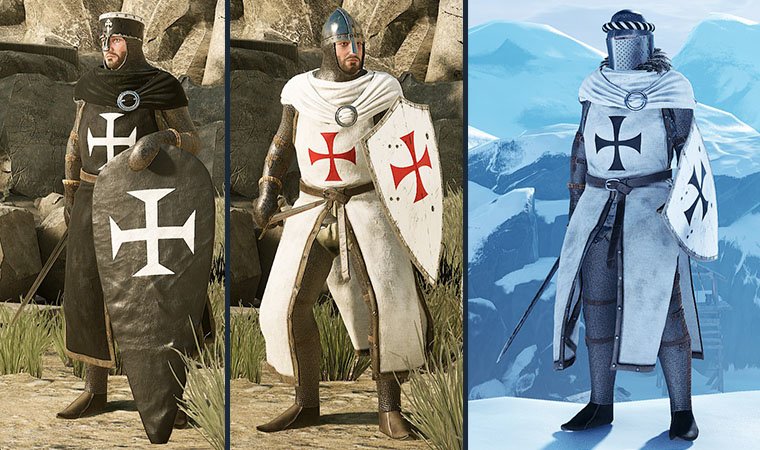

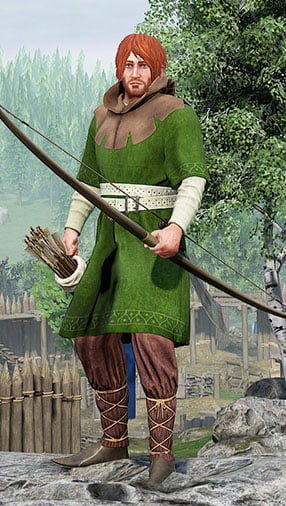
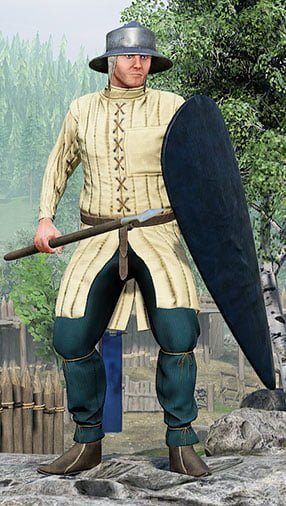
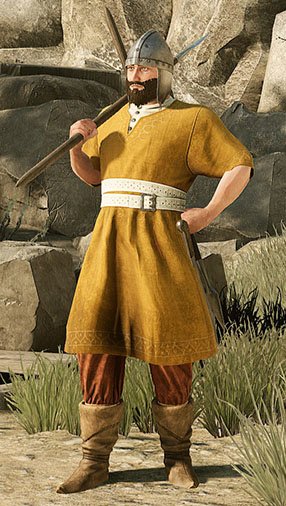
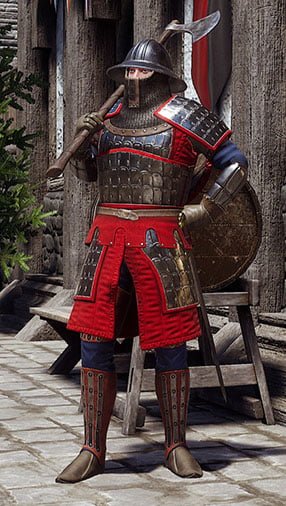
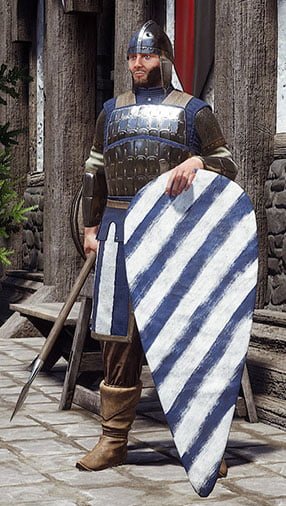
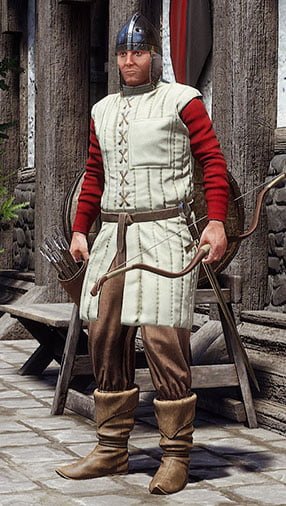
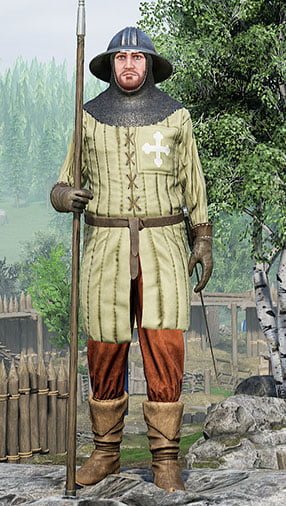
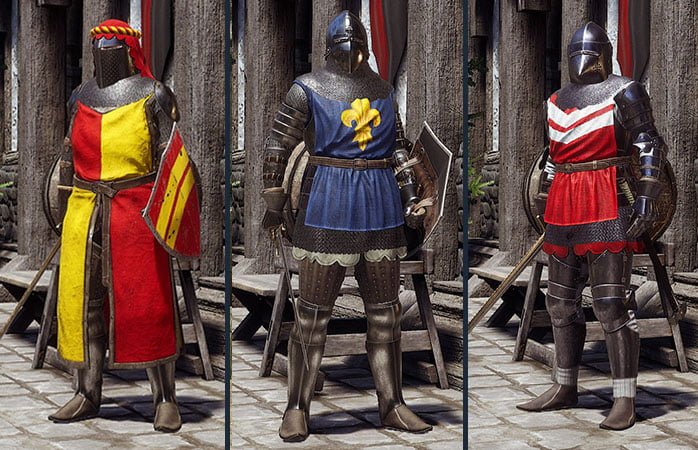

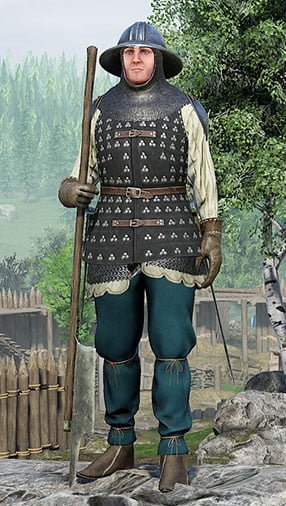



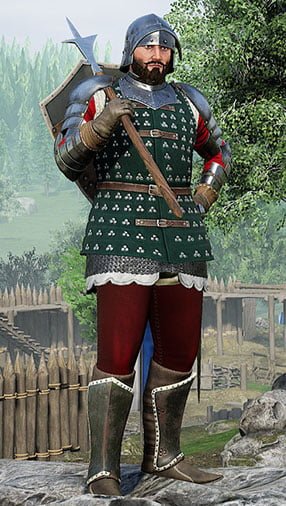

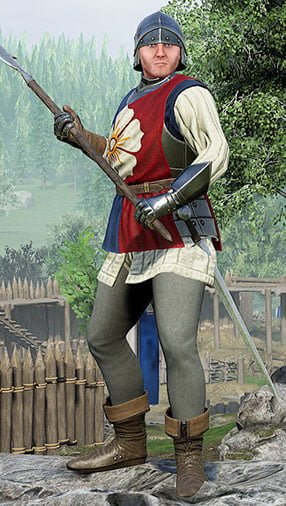

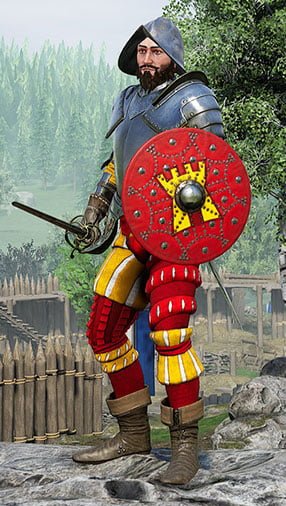
Add a Renesance Knight build, and add an arming cap for landsknecht, it looks way better with it